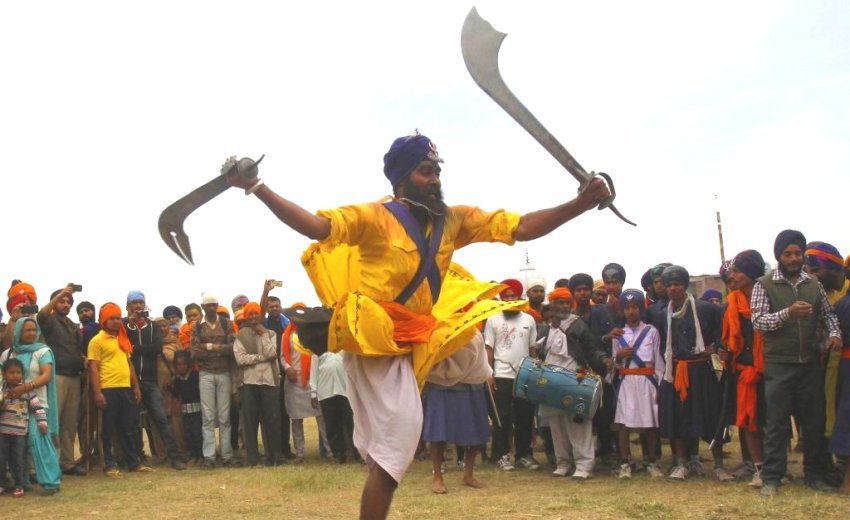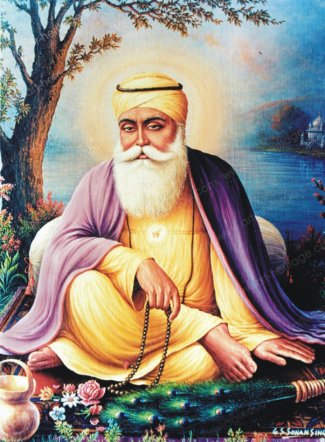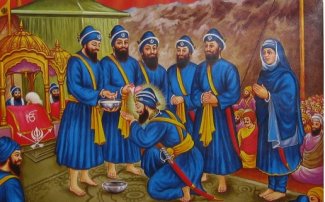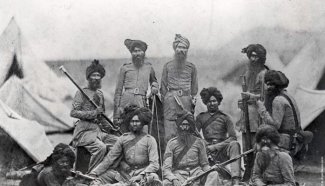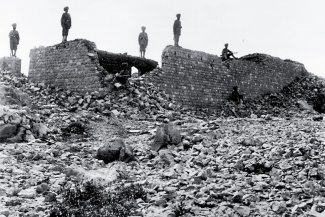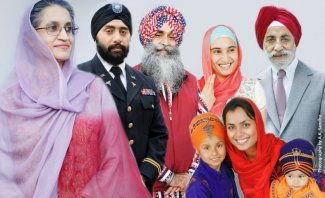The fifth-largest religion, unknown to many, is Sikhism. It was marked in 1469 with the birth of Guru Nanak. Sikhism is monotheistic, which means that Sikhs worship one god. The word Sikh itself refers to someone who is a “Seeker of Truth.” They value equality, valiance, and Seva (selfless service). Truthful living is a vital tenet of the Sikh religion. Myths have a myriad of functions. They play a profound purpose in understanding ancient cultures and belief systems. The final human destroyer of darkness, Guru Gobind Singh Ji established the Khalsa, a group that would be pure in heart and would exemplify good virtues and values. He initiated the Pure Ones because he wanted to protect those who were being religiously persecuted. Guru Gobind Singh Ji appointed the last name Singh (lion) for all men and Kaur (princess) for women. This and five distinctive symbols would have these individuals adhere to the highest form of morality. Throughout time, Sikhs have embraced their uniqueness and distinguishable identity by always standing up for what is right for humanity, even if it means that they sacrifice themselves.
In April of 1699, Sangat (congregation of men, women, and children - old and young alike) gathered at Anandpur Sahib. They “expected to hear a stirring speech [from Guru Gobind Singh Ji]” (Singh). Instead, “he addressed the congregation and demanded [a] sacrifice” (Bindra). He asked if any individual who loved the Guru and who followed the Guru’s command would offer him his head. Upon hearing this, the people trembled and worried. The Guru normally gave “blessings and happiness and now people could not believe their ears. The Guru wanted to kill one of his beloved Sikhs?” (Singh). The cry ran out again and many dispersed in horror. However, one individual, Daya Ram, rose and said, “O beloved Guru, my head has always been yours” (Singh). Guru Gobind Singh Ji took him inside a tent. He reappeared with a sword dripping in blood and asked for another head. “One by one four more earnest devotees (Dharm Das, Mokum Chand, Himmat Chand, and Sahib Chand) offered themselves to the Guru. Every time the Guru took one person inside the tent, he came out with a bloodied sword in his hand” (Bindra). The congregants began to disperse, believing that the Guru had lost his mind. However, he “emerged with all five piously [dressed] in white”(Bindra).
He did “not actually kill these disciples but used them as an example of courage to inspire the community” (“Khalsa”). Guru Gobind Singh Ji baptized them in a new and unique ceremony. He then told the “people that they were [made in] his own image; [the] Guru would be there wherever [the] Five Baptized Sikhs would together be” (Bindra). He referred to them as the “Panj Pyare,” the Five Beloved Ones. Guru Gobind Singh Ji enunciated that “the Khalsa is the Guru, and the Guru is the Khalsa. There is no difference between you and me” (Singh). With this, Guru Gobind Singh Ji devised the Khalsa. He prescribed “five symbols to make the Sikhs distinct in society” (Bindra). These symbols are “popularly known as Five Ks – Kesh - unshorn hair; Kangha - [a] comb; Karra - [an] iron bangle worn around the wrist; Kirpan - [a] sword; and, Kachehra - underwear” (Bindra). These are the emblems of “purity and courage, and identifiable among [millions] of people; a Sikh could never hide under cowardice” (Bindra). Along with this, Guru Gobind Singh Ji gave the “Panj Pyare” the appellation of Singhs (lions). Hence, Daya Ram was renamed Daya Singh, Dharam Das was renamed Dharam Singh, Mohkam Chand was renamed Mohkam Singh, Himmat Chand was renamed Himmat Singh, and Sahib Chand was renamed Sahib Singh. The Panj Pyare then baptized the Guru, and Gobind Rai was renamed Gobind Singh. Similarly, he designated the surname of Kaur (princess) to every woman.
The Birth of the Khalsa is the genesis of the Sikh religion because Guru Gobind Singh Ji transformed Sikhs into warriors. He established a military order that would inspire Sikhs during a time of persecution. It allowed them to have the “courage, will, and the strength to fight oppression” (“Khalsa”). However, this was not the only purpose of establishing the Khalsa. By doing so, Guru Gobind Singh Ji abolished social divisions. No one was superior or inferior to another. After the passing of Guru Nanak, nine destroyers of darkness were his successors. During these times, the Mughal Empire came to power. Many of the emperors viewed Sikhs as a threat and attempted to convert them by using force. Thus, many Sikh Gurus were executed because they refused to accept Islamic beliefs. Guru Tegh Bahadur, the ninth Guru, sacrificed his life for Hindu rajahs (kings) at that time. When the Hindu kings were ordered to convert to Islam or face death, they turned to Guru Tegh Bahadur for help. Guru Tegh Bahadur offered that if he was converted to Islam, the Hindu Kings would also do so. Guru Tegh Bahadur suffered extreme punishment and was beheaded. To protect their faith, Guru Gobind Singh Ji created the Khalsa to militarize Sikhs. This drastically changed the course of history and how battles were fought. However, this did not vanish at the death of Guru Gobind Singh Ji. Instead, even 322 years later, Sikhs have remained courageous and have always sacrificed themselves for the greater good of mankind.
During British rule, a group of valiant Sikhs gave their lives to defend the fort they were assigned to. The Battle of Saragarhi took place on September 12, 1897. It was a conflict between 21 Sikh soldiers and 10,000 Afghans. “Saragarhi was a communication relay post [that] played an important role in the defense and protection of the two main forts of the region, Fort Lockhart and Fort Gulistan” (Pant). The village was “turned into a heliograph communication post [because it] was located halfway between the two forts” (Pant). On September 12 at 9:00 am, the detachment commander, Havildar Ishar Singh, discovered that the Afgan soldiers were “approaching the post at Saragarhi. They numbered in the thousands, roughly around 10,000-12,000” (Pant). As Sepoy Gurmukh Singh noticed this, he decided to signal the “incoming invaders to Fort Lockhart via heliograph” (Pant). However, the Afghans had “strategically cut the supply route connecting Fort Lockhart and Saragarhi” (Pant).
Ergo, Fort Lockhart ordered the soldiers at Saragrahi to remain in their positions. Since they would not be receiving any aid from it, Havildar Ishar Singh held a meeting and asked all the soldiers “whether they would choose to abandon their posts for survival or hold the fort and put up a brave fight. The [warriors] chose the latter, unanimously” (Pant). When the Afghans approached the Saragrahi post, the Sikh soldiers began to fire their weapons, exterminating the first line of invaders. However, the Afghans “attacked them in two groups, one at the main gate and the other at the gap of the fort, knowing they would outnumber the Sikhs easily in this manner” (Pant). By noon, the “number of martyred soldiers rose to 11 with only 10 remaining to fight the battle” (Pant). Once they had breached the Saragarhi post, the Afghans “had to fight with only five remaining soldiers, four towards the inner side and one (Sepoy Gurmukh Singh) at the signaling tower” (Pant). Despite giving them a difficult time, the four valiant warriors were killed. Sepoy Gurmukh Singh then “signaled Fort Lockhart to get an approval to join the fight as he was the only one left” (Pant). Once he joined, the 19-year-old Gurmukh “single-handedly fought 20 [Afghans] before falling” (Pant). The Battle of Saragarhi is referred to as a heroic last stand because the 21 Sikh soldiers chose to fight until their last breath. In seven hours, the outnumbered Sikhs martyred nearly 600 Afghans. To reward their valiant behavior, all 21 Sikh soldiers were “posthumously awarded the Indian Order of Merit which was the highest gallantry award an Indian soldier could receive at that time” (Pant). In addition, Queen Victoria in the British Parliament in 1987 announced that “it is no exaggeration to record that the armies which possess the valiant Sikhs cannot face defeat in war” (Pant). Consequently, September 12, 1897, was truly a heroic last stand.
The dauntlessness of Sikhs was not only present in the 17th and 19thcenturies, it is still visible today. During India’s Covid-19 crisis, a Sikh-led non-profit organization, KhalsaAid, has administered free oxygen concentrators to all. Moreover, they have provided food, water, medications, and free ambulance services to those in need, regardless of their religion. This is not only present in India. KhalsaAid has helped a plethora of countries including, Syria, Bangladesh, the United Kingdom, Australia, and finally, Greece. The founder and CEO of this organization, Ravi Singh, believes in helping the world because everyone is equal. This is based on the ideologies that Guru Gobind Singh Ji bestowed upon the Sikhs when he established the Khalsa. Furthermore, newlyweds, Ishaan Singh and Paramjyot Kaur decided to help those who were in need instead of attending their honeymoon. When asked why they chose this over the latter, Ishaan Singh said that “it’s the passion that [he] has inside [him] that comes from Sikhism. From our history, our Gurus, our Sikhs have done for the people, they have sacrificed their lives for humanity” (ABC News). These examples reveal that Sikhs have always put others before themselves no matter what.
Myths reflect themes that are vital in a culture. Beliefs and practices of religion, social systems, and laws, expected behaviors, ways of everyday life, customs, and lastly, origins of geographical features are all functions of myths. In this case, the Birth of the Khalsa unveils why Sikhs have always been prepared to sacrifice themselves for the greater good of humanity. From the Panj Pyare, the Battle of Saragarhi, and finally, to the Covid-19 crisis in India, Sikhs were willing to pay the ultimate price. Therefore, throughout time, Sikhs have embraced their uniqueness and distinguishable identity by always standing up for what is right for humanity, even if it means that they will sacrifice themselves.
